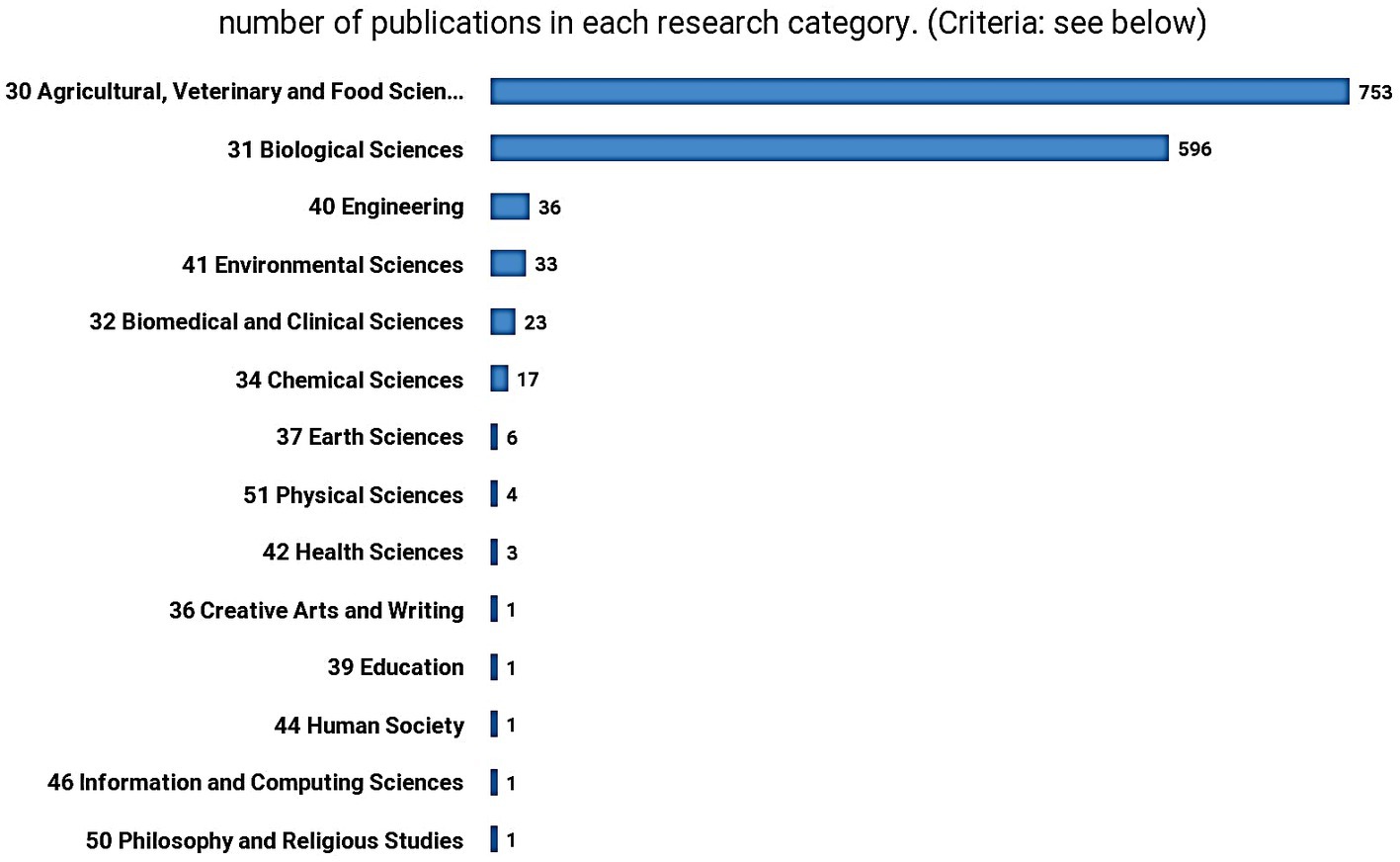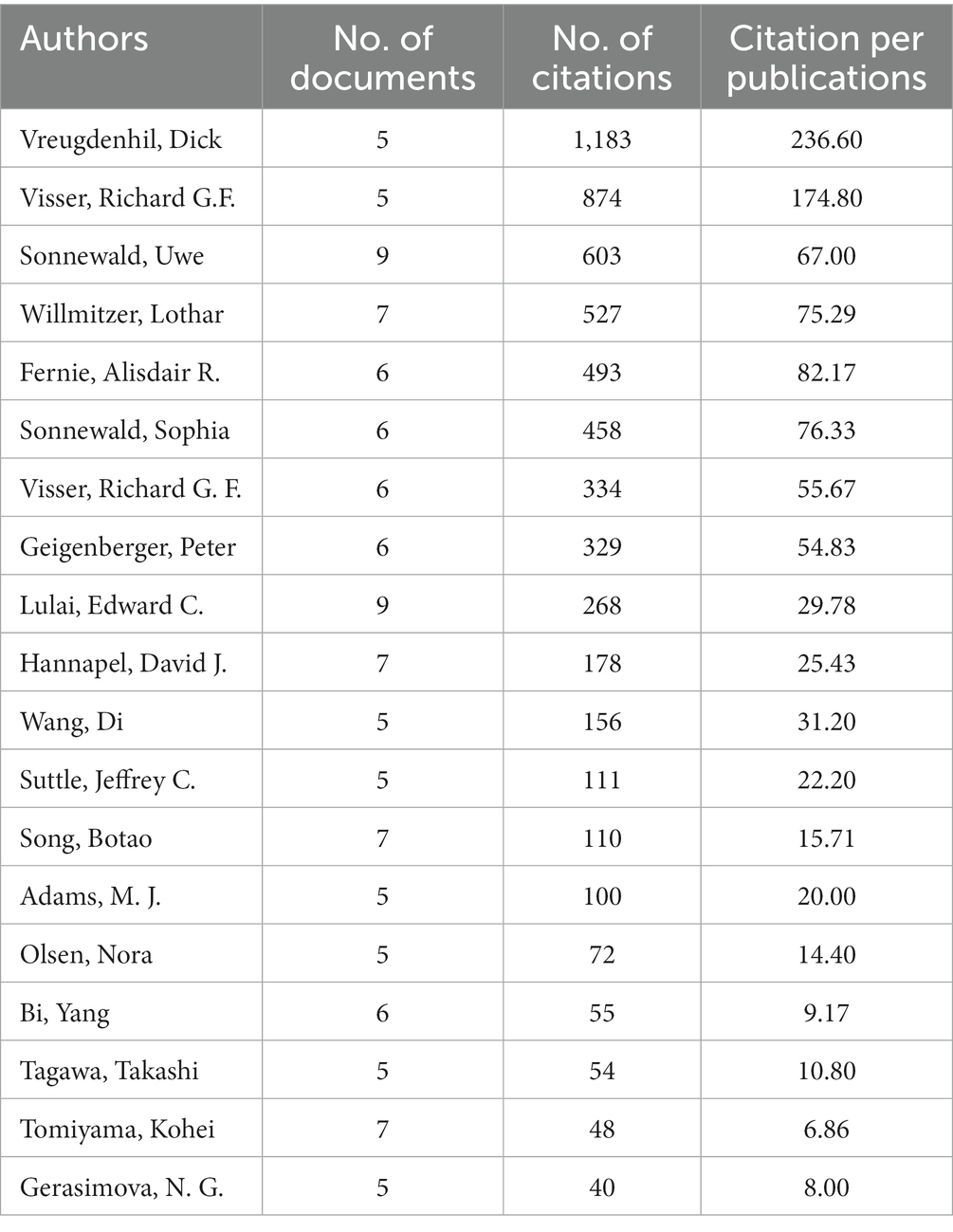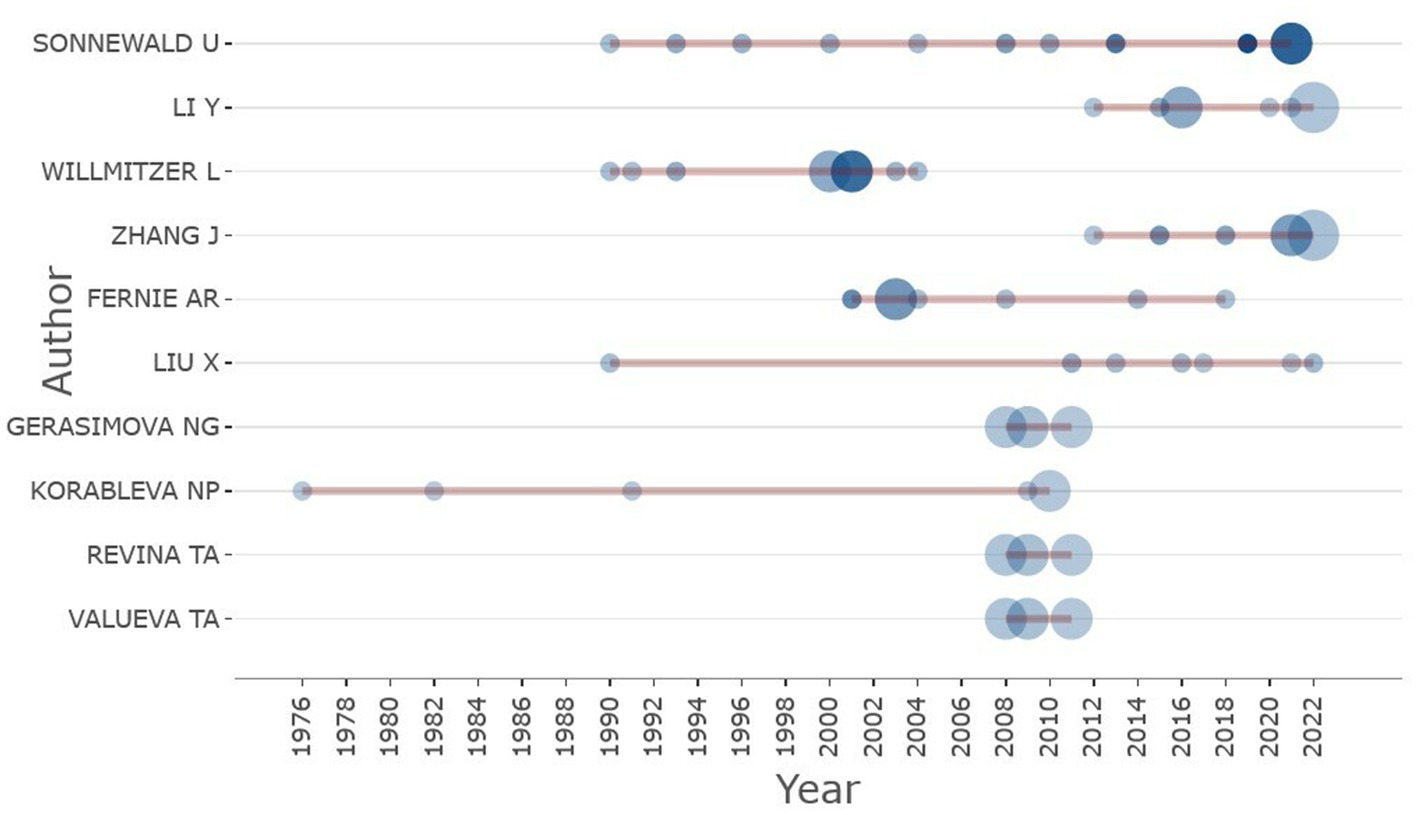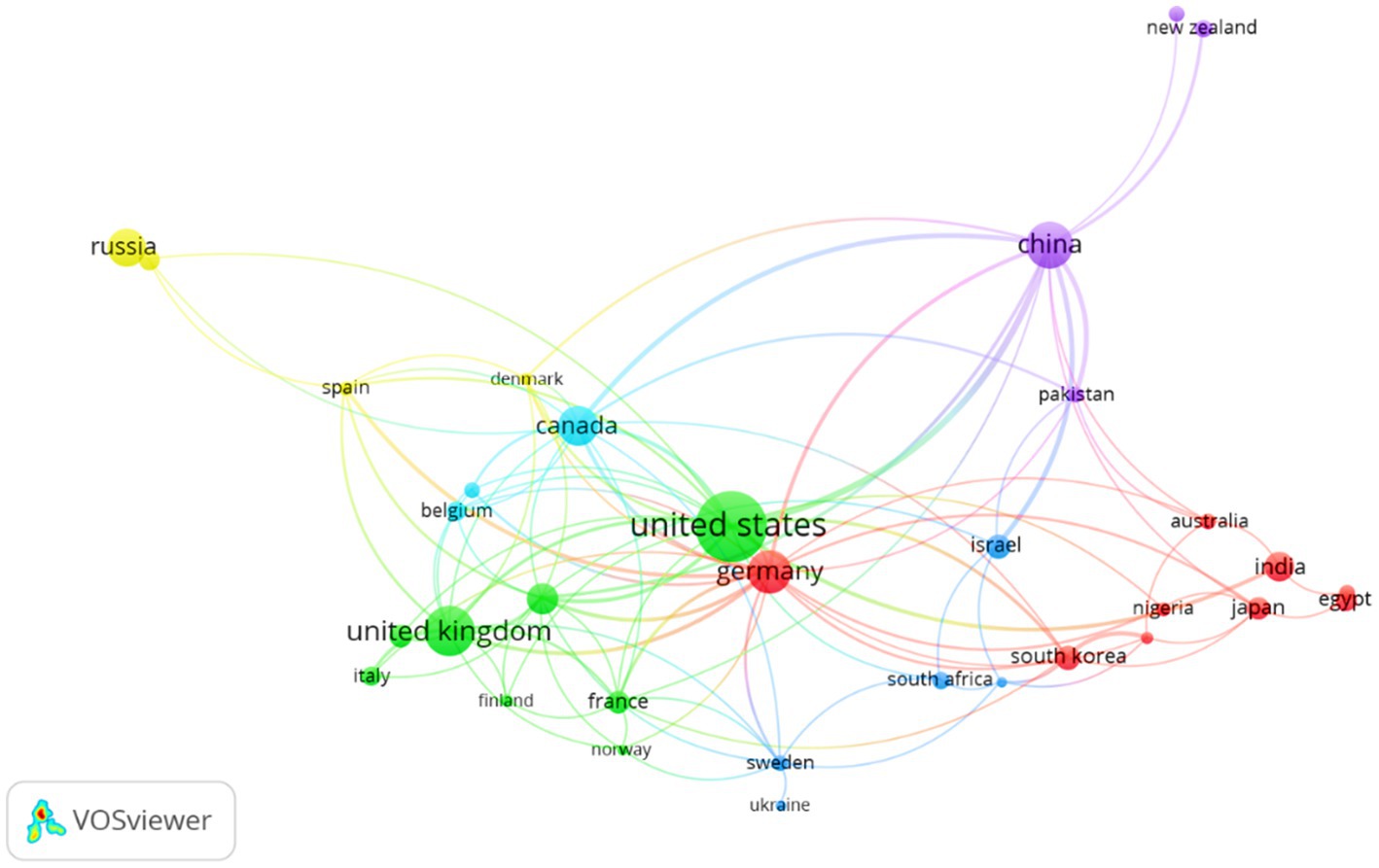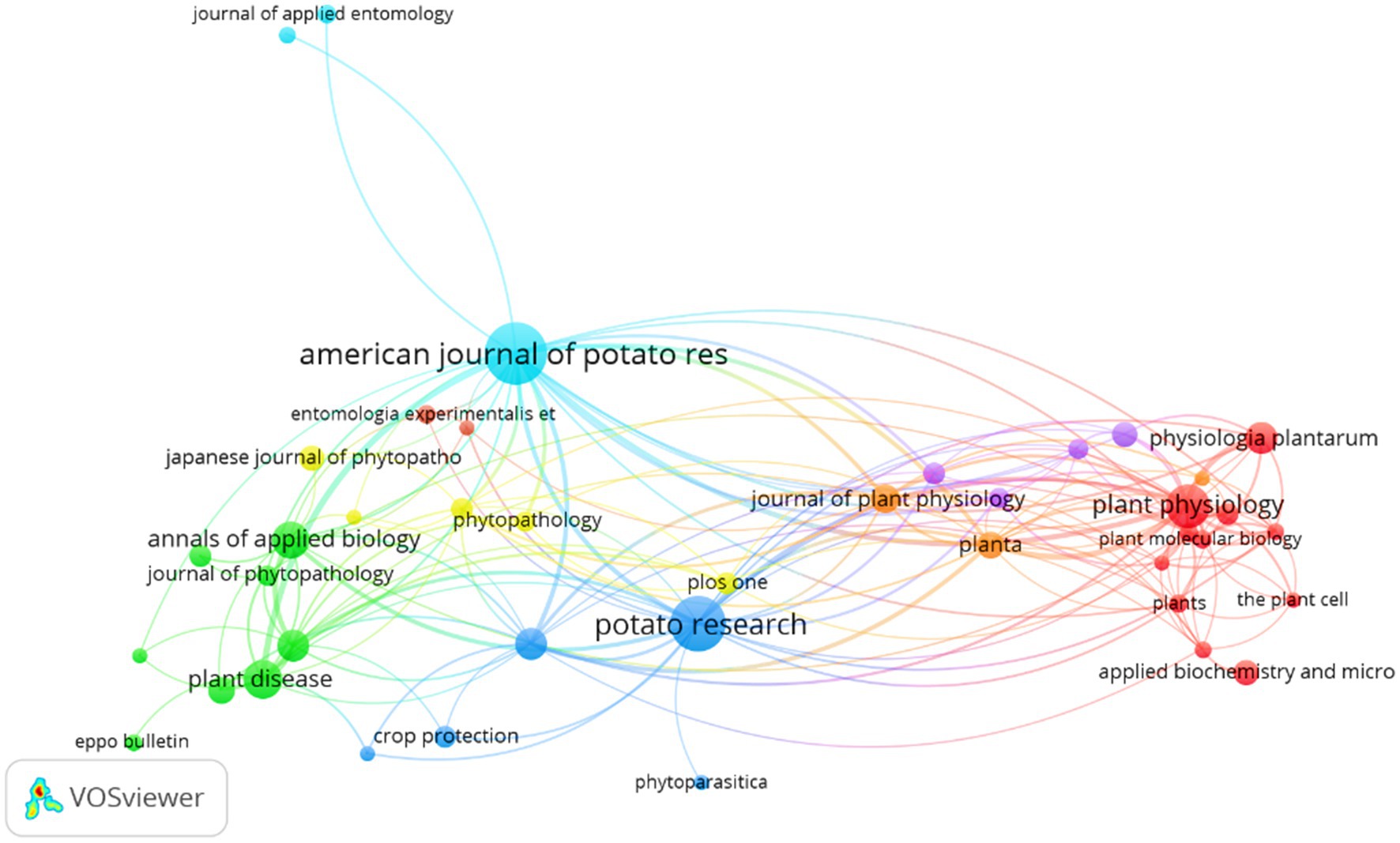Exploring potato seed research: a bibliometric approach towards sustainable food security
- 1Department of Agricultural Economics & Extension, Lovely Professional University, Phagwara, Punjab, India
- 2ICAR-Central Potato Research Institute, Shimla, Himachal Pradesh, India
- 3ICAR-Indian Institute of Water Management, Bhubaneswar, Odisha, India
- 4Division of Agronomy, Rajasthan Agricultural Research Institute, Sri Karan Narendra Agriculture University, Jobner, Jaipur, India
- 5Department of Molecular Biology and Biochemistry, Guru Nanak Dev University, Amritsar, Punjab, India
- 6College of Horticulture, Hainan University, Haikou, China
- 7ICAR-National Rice Research Institute, Cuttack, Odisha, India
- 8Department of Clinical Pharmacy, College of Pharmacy, King Saud University, Riyadh, Saudi Arabia
- 9Department of Life Sciences, Presidency University, Kolkata, India
Introduction: Potato is considered to be complete food that will not only ensure food security but also alleviate poverty. Seed production of potato requires specific temperatures and conditions. In response to the growing emphasis on sustainable production, there has been an increasing focus on research on tuber seed production.
Methods: In our study, we have employed bibliometric analysis to investigate the trends in potato seed research and assess its correlation with sustainable development. Tabular analysis and network analysis are employed in the study to understand the prominent authors and institutions and research trends across time. For this purpose, Biblioshiny and Vosviewer software were used. The steps of bibliometric analysis were used, which included data retrieval from Dimensions software. Owing to its limitations, a major analysis was conducted without affecting the results.
Result and discussion: It was found from the analysis that it was SDG 2 that was mostly linked with the theme of potato seed production. The results depicted an increasing trend of publications and citations. Co-authorship analysis of authors showed high linkage among groups of authors that formed clusters while other authors remained disconnected. Among countries United States, China and the United Kingdom had a higher impact on publications and citations. Our analysis showed that there is still scope for collaboration among countries as there is no evidence of multidisciplinary interlinkages. By understanding the current research landscape, identifying influential works and authors, and uncovering collaboration patterns, we can pave the way for future advancements in potato seed production. Ultimately, this research contributes to achieving sustainable agriculture and ensuring food security for future generations.
Introduction
Potatoes are a vital crop worldwide, potentially contributing to food security greatly. Potatoes have been recognized by the Food and Agriculture Organization (FAO) as an exceptional crop due to their high nutritional value and ability to produce a substantial amount of dry matter per unit area and time (Devaux et al., 2019). The FAO declared 2008 as the “International Year of Potato” to recognize the crucial role that potatoes can play in addressing global food security and poverty alleviation. Potatoes are grown on an area of 18.13 million hectares, accounting for 376.12 million tons of global production (Singh et al., 2023). Forecasts indicate that its production could double within 25 years at the global level. According to the Food and Agriculture Organization (FAO), the most substantial increases in potato production are anticipated in Asia and Africa, whereas Europe and North America are experiencing a decline in production (Pandey et al., 2009; Devaux et al., 2021; Goffart et al., 2022).
Given these circumstances, cultivating potatoes presents an exceptional opportunity for developing nations to ensure food security and alleviate poverty. With its unmatched ability to produce a high yield of nutritious and versatile crops, potato farming can play a significant role in meeting the food needs of the growing population in developing countries (Kumar et al., 2021, 2022). While staple crops continue to be essential for energy needs, potatoes can enhance dietary quality with their rich vitamins, minerals, and superior protein content. Instead of replacing staple foods, potatoes can complement a well-rounded diet that includes various vegetables and whole grains. Moreover, potatoes can play a role in addressing the prevalent issue of micronutrient deficiencies, commonly known as “hidden hunger,” which impacts roughly two billion individuals worldwide (Nagaich et al., 1969; Frost et al., 2013).
As the foundation for a successful potato harvest, seed potatoes play a crucial role in the larger agricultural framework. To ensure access to high-quality seed potatoes free of diseases and pests, seed potato production has been a global priority (Paul et al., 2016, 2022). Yield, quality, and health of the crop are directly influenced by the quality of seed potatoes (Janssens et al., 2013). In various countries, certification programs have been established to regulate and improve seed potato quality. In these programs, seed potatoes are produced that are disease-free, especially those that are resistant to devastating diseases like potato blight. In addition to genetic purity, vigor and vigor are also priorities to ensure that the seeds retain the characteristics of the parent variety (Hoekstra, 2008).
Seed potatoes need to be stored carefully once they have been produced. Proper storage is crucial to preserve the viability and health of the seed. Storage facilities should maintain a controlled humidity level and a cool but not freezing temperature to prevent seeds from drying out or rotting (Kumar et al., 2023). Ventilation is also essential to prevent the buildup of harmful gasses. Seed potatoes have a longer shelf life and fewer losses due to improvements in storage technology. In order to ensure global food security, seed potatoes must be produced and stored. Not only do they ensure a consistent supply of potatoes, which are a staple in most diets, but they also stabilize the economies of regions dependent on potato farming. Seed potato production and storage systems will become increasingly important as climate change and global food demand increase (Kumar et al., 2021, 2022).
China is the world’s largest potato producer, followed by India, the Russian Federation, and Ukraine. Despite the growing demand for potatoes in world due to population growth, the crop faces numerous challenges that interfere with its production and yield potential. Seed potatoes play a crucial role in determining the success of potato crops. According to research, a healthy seed potato can enhance crop yield, reduce diseases, and improve overall crop quality. In addition to fungal and bacterial diseases, seed potatoes may carry viruses and fungi. Reducing the spread of these diseases by using certified disease-free seed potatoes and promoting healthy plant growth is possible. Healthy seed potatoes produce more vigorous and uniform plants, which results in better potato yields. In addition, healthy plants are better equipped to withstand stress factors such as drought, heat, and cold, ultimately improving the quality of potatoes. Furthermore, using healthy seed potatoes can potentially reduce the use of pesticides since healthy plants are more resistant to diseases and pests (Ezekiel and Singh, 2007a,b). Therefore, using healthy seed potatoes offers farmers significant benefits, including cost savings.
There is a shortage of good-quality potato seeds in developing countries. However, potato cultivation and improvement have been significantly improved with the help of conventional and modern biotechnologies. In addition to enhancing domestic potato production, producing high-quality seed potatoes is crucial for meeting the minimum commercial quality standards mandated by international agreements. Under the Sanitary and Phytosanitary Agreement of the World Trade Organization, pathogens in seed potatoes are considered a significant quality concern. Several countries in the region are developing or modifying their potato certification standards to align with international seed standards to facilitate fair international trade and encourage high-quality seed production (FAOSTAT, 2019). These initiatives are expected to eliminate technical barriers and ensure farmers’ profitability.
Additionally, conducting a bibliometric analysis of potato research could provide valuable insights into the existing literature and research trends. Citation patterns, publication outputs, and collaboration networks can provide insight into key contributors, emerging areas of interest, and research gaps. Such an analysis would enhance the manuscript by providing a quantitative evaluation of the research landscape related to potato cultivation and improvement.
Potato crops are typically grown using tubers as the seed material. However, the repeated use of seed material leads to rapid degeneration, making it necessary to replace basic seed material every year or at least every 2 years (Almekinders et al., 2009). Good quality seed material is either unavailable or is beyond most farmers’ financial means due to high prices. The importance of good quality seed material is evident from the fact that it alone can enhance yields by up to 15–20% (Shaheb et al., 2015). The multiplication ratio of conventional seed potatoes ranges from 1:8 to 1:15, depending on factors such as cultivars, stage, weather conditions, and crop management practices. Multiplying seed potatoes takes a significant amount of time, equivalent to one cropping season (approximately 4 months). A higher multiplication rate and faster processes are necessary to meet current and future demands. Therefore, alternative methods of seed potato production are needed. These alternative methods should be rapid, low cost, and yield good quality seed potatoes that can integrate well into the existing potato production system. In recent years, significant progress has been made in developing several rapid multiplication techniques for potato propagation (Buckseth et al., 2022).
Potato seed development, which refers to the propagation material utilized to generate the crop, is an important part of potato cultivation. Understanding the physiology of seed growth and determining the appropriate seed management practices are critical to effective crop yield. Potato is a major crop worldwide, with several culinary, feed, and industrial applications. Potato seed development is important to potato cultivation since it impacts crop quality and output (Rahman and Akanda, 1970; Zhang et al., 2018). Due to the growing global demand for sustainable agriculture, potato seed development has received much attention from researchers, politicians, and agricultural stakeholders. The heightened emphasis on sustainable production has led to a surge in research on developing potato seeds. This research primarily focuses on enhancing crop yield, reducing pesticide usage, and promoting sustainable practices in potato cultivation (Pretty et al., 2003).
Bibliometric analysis is a useful method for quantitatively analyzing research literature and providing insights into the evolution of research on a specific topic. In the case of potato seed development, bibliometric analysis can assist in identifying the most important research topics, the most prominent authors and institutions, and research trends across time. According to Sattar et al. (2021) potato seed development research has progressively increased over the last few decades. The study examined 1,799 research publications published in the Web of Science database between 1990 and 2020. According to the data, the number of publications on potato seed development increased dramatically from the 2000s to 2019, peaking in 2019 (Sattar et al., 2021). The survey also identified the top authors, institutions, and nations contributing to this field’s research.
Several key factors were highlighted in the study to foster sustainable potato production, including seed certification, quality control, and access to improved potato varieties. Furthermore, the authors emphasized the importance of interdisciplinary research and stakeholder collaboration when dealing with potato seed development. Aiming to address the pertinent issues in potato seed research and advance sustainable agricultural practices, the study integrates expertise from diverse fields. Overall, a bibliometric study of research on potato seed development and its relationship to sustainable development can provide significant insights into current knowledge and identify emerging research trends (Nagaich et al., 1969; Jefferies, 1996; Patel et al., 2020). This research can assist policymakers and agricultural stakeholders in building evidence-based policies to promote sustainable potato production.
This study examines trends in potato seed research over time. We use bibliometric analysis to identify patterns and changes related to potato seed production in the publication output. It involves analyzing the number of publications and citations related to potato seed research. Moreover, potato seed research regarding its impact on sustainable development should be evaluated. In this study, we examine whether potato seed production is aligned with the Sustainable Development Goals (SDGs), particularly SDG 2, which deals with food security. Our goal is to identify key authors and institutions involved in potato seed research. We will use bibliometric analysis to identify the most prolific authors and influential institutions in this field. The objective also involves exploring co-authorship patterns and analyzing the formation of author clusters to assess the extent of collaboration and interlinkages among researchers in potato seed research. To achieve these objectives, bibliometric analysis will be used to investigate the trends, thematic associations, and collaborative networks within potato seed research and their relationship with sustainable development.
Materials and methods
Bibliometric analysis is a quantitative research method that involves the analysis of bibliographic data, such as citation patterns and publication characteristics, to gain insights into scientific publications (de Sousa, 2021). A bibliometric analysis was employed to investigate the field in depth in the context of potato seed development. This methodology involves a comprehensive and systematic analysis of various bibliographic factors, such as the number of publications, authors, journals, keywords, and citations. By examining these factors, researchers can identify key trends, patterns, and connections within the field of potato seed development.
Formulation of a study topic and objective
Before embarking on bibliometric analysis, it is essential to establish clear research questions and objectives. After conducting a thorough literature review, the study identified the following research questions:
a. What are the major research trends and contributors in potato seed development?
b. Who are the most prolific authors in your field of study?
c. What are the authors’ most frequently used keywords?
d. Who are the influential institutes in potato seed development?
e. How does research on potato seed development differ across areas or countries?
f. What are the most regularly used potato seed development varieties or cultivars, and how have they evolved through time?
g. What are the most commonly cited publications in potato seed development, and how do they impact the field?
h. What research category and long-term aims does potato seed development research serve?
These researchable questions can be modified, analyzed, and adapted based on unique research interests and objectives. The following step was to generate a specific search category.
Database selection and search query
Searching for relevant scientific papers involves the selection of appropriate databases and search phrases (Groos and Pritchard, 1969). Some of the most important databases in potato seed production include Web of Science, Scopus, Dimensions, and Google Scholar. For this study, we chose to use the Dimensions database due to the limitations of Web of Science and Scopus, which require a high-priced subscription. Dimension is a popular database for citation analysis, and the choice of data source typically depends on the research objectives (Aliche et al., 2020). Although Dimensions provides large raw data, data cleansing is rigorous and time-consuming. To ensure the relevance of the results, we used specific search phrases such as “potato seed development,” “potato breeding,” “potato cultivars,” and “potato tuber.” These phrases were carefully chosen to retrieve papers related to our research topic (Martín-Martín et al., 2018, 2021).
Retrieve and filter the publications
After completing the search, the next step was to retrieve and filter the articles based on their relevance and quality. For our study, we only considered articles classified as research articles and restricted our literature search to articles published in English. We selected a study period of 1974–2023, and to avoid any potential bias, we downloaded all relevant data on a single day. In total, our search engine retrieved 1984 documents for analysis. To ensure our findings’ reliability and validity, we cleaned the data to eliminate any undesired or incomplete articles. As a result of this process, only 1,145 papers remained for our bibliometric analysis. Overall, data cleaning is a critical step in bibliometric analysis, as it helps to remove any irrelevant or low-quality data, ensuring that the remaining data is of high quality and relevant to the research question. Data cleaning can be time-consuming and requires careful attention to detail, but it is essential for obtaining accurate and meaningful results (Roemer and Borchardt, 2015).
Analyze the bibliographic data
Bibliographic data includes key information such as author names, publication years, journal titles, and citation counts. To analyze this data, we utilized a range of bibliometric variables such as the number of publications, citation rates, and frequently used word analysis (van Eck et al., 2010; van Eck and Waltman, 2017). We also employed various bibliometric indicators, including co-authorship analysis, bibliographic coupling analysis, and co-citation analysis. Our study used the R programming language and the built-in Biblioshiny package to perform our bibliometric analysis. Additionally, we employed Vosviewer, a network analysis tool, to visualize the relationships between the publications and authors. Using these tools allowed us to gain a more comprehensive understanding of the trends and patterns within the field of potato seed development. We identified key authors, publications, and research areas by analyzing the bibliographic data and visualizing their connections. This information can guide future research, identify potential collaborations, and inform decision-making in the field (Afrifa et al., 2022).
Interpret the findings
After analyzing the bibliometric data, the findings were evaluated in light of our research question and objectives. We identified major trends, influential authors, and research collaborations in potato seed development. This information allowed us to gain a more in-depth understanding of the field’s current state and identify areas for further research. The findings from our bibliometric analysis were utilized to identify gaps in the existing literature and potential avenues for future research (van Eck and Waltman, 2011). For example, we may have found that certain areas of potato seed development are under-researched or that certain research collaborations have been particularly fruitful. These insights can guide future research efforts and prioritize research topics with the greatest potential to contribute to the field. The findings from our bibliometric analysis were instrumental in informing our research and identifying opportunities for future research. By applying bibliometric analysis to our research question, we gained a more comprehensive understanding of potato seed development and identified ways to advance our knowledge in this area (Pizzi et al., 2020; Lal et al., 2023).
Results and discussion
Trends in publication
The data analysis collected from Dimensions has yielded valuable insights into potato seed development research. One notable trend observed is the increase in the number of publications, which indicates the growing scope and interest in this area of research. We employed bibliometric analysis to track this trend over time, a powerful tool that enables us to identify emerging or declining research areas (do Prado et al., 2016). Potatoes share similarities with other staple food crops such as rice, wheat, banana, and cassava. As economies grow and develop, consumers tend to broaden their diets and seek out more costly energy and protein sources, especially animal products, fruits, and vegetables. In regions where potatoes are not a primary staple, they are often incorporated into diets as a more expensive vegetable option (Patel et al., 2020). By monitoring the number of publications each year, we can better understand the evolving landscape of potato seed development research. This information can be especially useful in identifying research areas that are gaining or losing prominence and allocating resources to the most productive or impactful research areas. Bibliometric analysis has proven to be an effective method for analyzing research output and identifying trends in various fields. Its application in potato seed development research has provided valuable insights that can inform future research efforts and resource allocation strategies. As per capita income rises, the consumption of the staple food crop typically decreases over time. This trend reflects a general shift toward more diverse and nutritious diets, which can accommodate a wider range of food options beyond basic staples. As a versatile and nutritious vegetable, potatoes are often incorporated into these diversified diets as a valuable source of vitamins, minerals, and dietary fiber (Walker et al., 1999).
In the current study, Figure 1 displays the publication trends over a study period from 1974 to 2022, which shows a consistent increase in publications, culminating in a peak in the year 2020. This trend indicates a substantial increase in productivity in the field of interest. However, the number of publications alone does not necessarily reflect the impact of the research conducted. To evaluate the impact of the research, citation analysis was conducted, and the results are depicted in Figure 2. The graph clearly illustrates that the number of citations has been consistently increasing every year, and the rate of increase has been accelerating over time. This suggests that the research conducted in the field has been increasingly influential, as demonstrated by the growing number of citations it has received. Therefore, while Figure 1 shows a measure of productivity, Figure 2 provides a more nuanced view of the research impact, indicating that the field has generated influential research that has garnered increasing attention and recognition from the scholarly community.
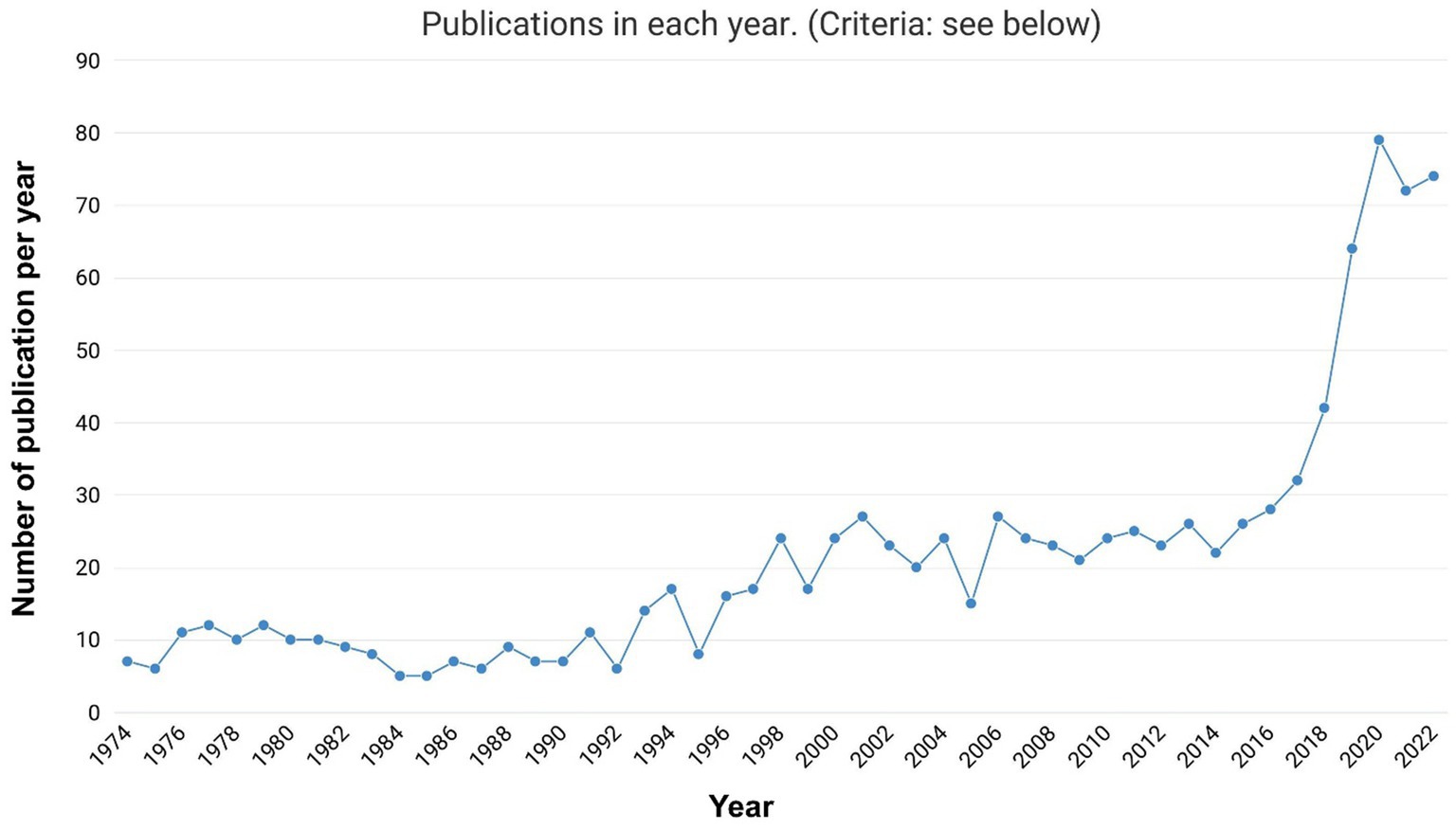
Figure 1. Trends in publications (1974–2022) on the area of research on potato seed development around the globe.
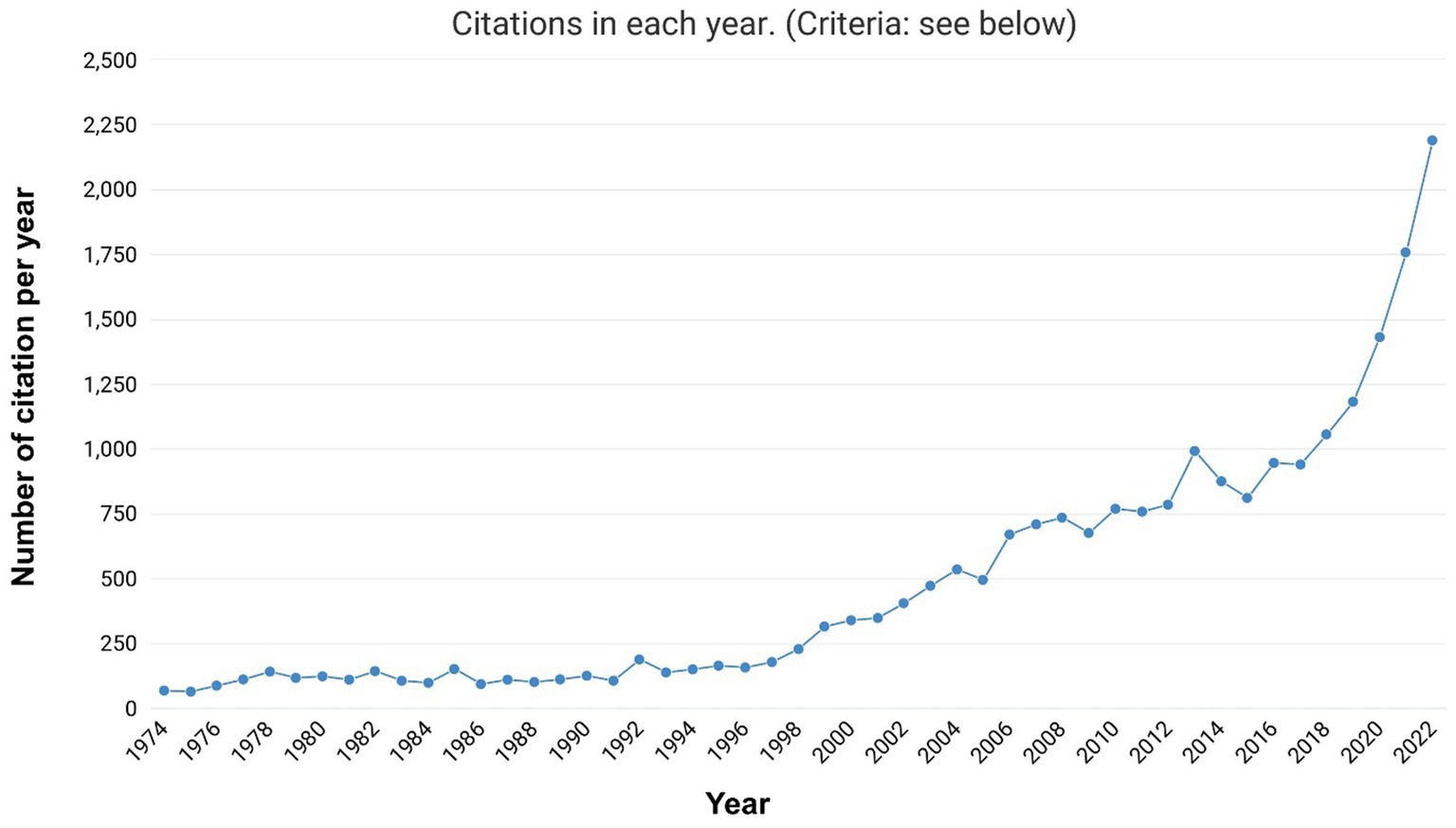
Figure 2. Citations over time (1974–2022) of the area related to potato seed development around the globe.
Bibliometric analysis is used to assess the quality and effect of research and identify trends and patterns in scientific publications. The number of citations received each year reflects the popularity and effect of scientific works. It depicts the evolution of research trends across time. Bibliometric analysis often uses the number of publications as a key indicator, particularly when evaluating the performance of individual academics or research groups. The number of publications is considered a valuable measure of research productivity and is frequently used to make comparisons among scholars or research groups. In this study, we have analyzed the number of publications across different scientific categories. Figure 3 illustrates the total number of publications published in each category, providing valuable insights into the distribution of research output within the scientific community.
The graph reveals that the agriculture category has the highest number of publications, closely followed by Biosciences. However, it is important to note that the number of publications alone may not necessarily indicate research quality or impact. Other bibliometric indicators such as citation counts, co-authorship patterns, and journal impact factors should be considered to gain a more comprehensive understanding of research performance. These metrics can provide a more nuanced evaluation of research impact and productivity and help identify research areas that are making significant contributions to their respective fields. Therefore, using multiple indicators in bibliometric analysis is crucial to gain a more accurate and comprehensive picture of research performance.
Furthermore, the importance of the number of publications varies depending on the topic of study. As a result, while the number of publications is important in bibliometric analysis, it should be analyzed with other indicators to provide a more thorough assessment of research performance. Further research was conducted to examine publications on the Sustainable Development Goals (SDGs). The bibliometric analysis involved identifying, analyzing, and evaluating research relevant to the 17 SDGs approved by the United Nations in 2015o to measure progress toward these goals (Sweileh, 2020). To understand the distribution of research output across different SDG themes, Figure 4 presents the analysis outcomes, with publications categorized by study theme. This analysis provides valuable insights into the areas of research that have been most active in addressing the SDGs and can help to identify areas where more research is needed to achieve these goals.

Figure 4. Total number of publications on the area of potato seed development and sustainability in each SDG theme.
Bibliometric analysis of SDG-related publishing trends can provide valuable information about research gaps and emerging topics and mapping networks and collaborations between researchers and institutions working on SDGs. The graph displaying the publication themes related to potato seed growth, which is linked to SDG 2: Zero Hunger, followed by Good Health and Wellbeing, highlights the crucial role of publications in informing policy decisions, funding priorities, and research initiatives aimed at achieving the SDGs. By analyzing SDG publication output, policymakers and funders can identify areas where research efforts must be focused on accelerating progress toward meeting these goals. The bibliometric analysis provides a comprehensive record of SDG-related research output, enabling a more in-depth understanding of progress toward achieving the SDGs. As such, publications play a vital role in SDG bibliometric analysis, helping to inform evidence-based decisions to achieve sustainable development objectives.
Productive authors
The Dimensions dataset was analyzed to identify the most productive group of authors. The significance of the document was demonstrated by its citation by the authors. We identified 20 highly productive authors based on their citations during the investigation. The findings have been summarized in Table 1. This analysis provides valuable insights into the most influential researchers in a particular field and their contribution to advancing knowledge in the field.
Table 1 presents the authors in descending order of the number of citations they received. To better understand the actual impact of a particular author, citation per publication was calculated. The analysis revealed that authors with more than 500 citations also tended to have a higher citation per publication, indicating the impact and quality of their research. Citation per publication is an important bibliometric indicator that measures the quality of an author’s research output. This metric provides a more realistic view of the effect of a researcher’s work than simply looking at the number of citations to their work. The work of researchers with a high citation per publication score may have a greater impact on their area and the research agendas and policy decisions made.
Authors’ production over time
Understanding the productivity and impact of an author is crucial in assessing their relevance within a particular field. In Figure 5, both metrics provide an overview of the top 10 most productive authors in the last 30 years. Productivity is assessed based on the number of papers an author has produced within a specific period. On the other hand, the impact is measured by the number of citations received per year. The circle size in the figure indicates the number of publications by each author in a given year, while the color depth indicates the number of citations received per year. From the graph, it is clear that Sonnewald and Willmitzer are the most productive authors, with Sonnewald being a seminal author on the subject, having published nearly every year from 1990 to 2018. However, Li Y and Zhang J have the highest number of citations annually, indicating their significant impact on the field. The bibliometric analysis shown in Figure 5 provides a useful tool for understanding the productivity and impact of researchers in a particular field. By identifying influential authors, policymakers, funding agencies, and academic institutions can direct resources toward research initiatives that have the potential to yield the most significant impact. Additionally, identifying productive authors can help to promote collaboration between researchers and institutions, further advancing research in the field.
Co-authorship analysis of authors
A Co-authorship analysis is a commonly used method to study collaborations between authors. In this approach, co-authorship networks are constructed, where authors are represented as nodes, and the co-authorship interactions are represented as bubbles or edges. These networks provide a visual representation of the collaboration patterns among authors and can reveal important information about the structure of the research community. One way to analyze these networks is by using network measures such as degree centrality, betweenness centrality, and clustering coefficients. Degree centrality refers to the number of co-authorship relationships an author has, while betweenness centrality measures the extent to which an author connects different parts of the network. Clustering coefficients measure the density of the network and the degree to which authors cluster together. By using these network measures, notable authors and research clusters can be identified, and the overall structure of the co-authorship network can be analyzed. This type of analysis can help identify key players in the field and potential research gaps or collaborations that can be further explored. The co-authorship analysis provides a valuable tool for understanding collaborations between authors and can offer insights into the overall structure and dynamics of the research community.
In Figure 6, we can observe the co-authorship network among the authors in the dataset. Each node in the network represents an author, and the links between the nodes indicate a co-authorship relationship between the authors. The size of the node represents the number of publications by the author, and the color of the node indicates the country of the author’s affiliation. The network analysis reveals several tightly connected research groups, as evidenced by the clusters of nodes with similar colors. Additionally, our bibliometric analysis allows us to identify several authors who significantly influence the network. These authors exhibit numerous co-authorships with other researchers, positioning them at the network’s core and giving them a high degree of betweenness centrality. This finding suggests that these authors play a crucial role as intermediaries between different research groups, actively facilitating collaboration and knowledge exchange. Their prominent position within the network highlights their potential to drive research synergies and foster a collaborative research environment in potato seed research.
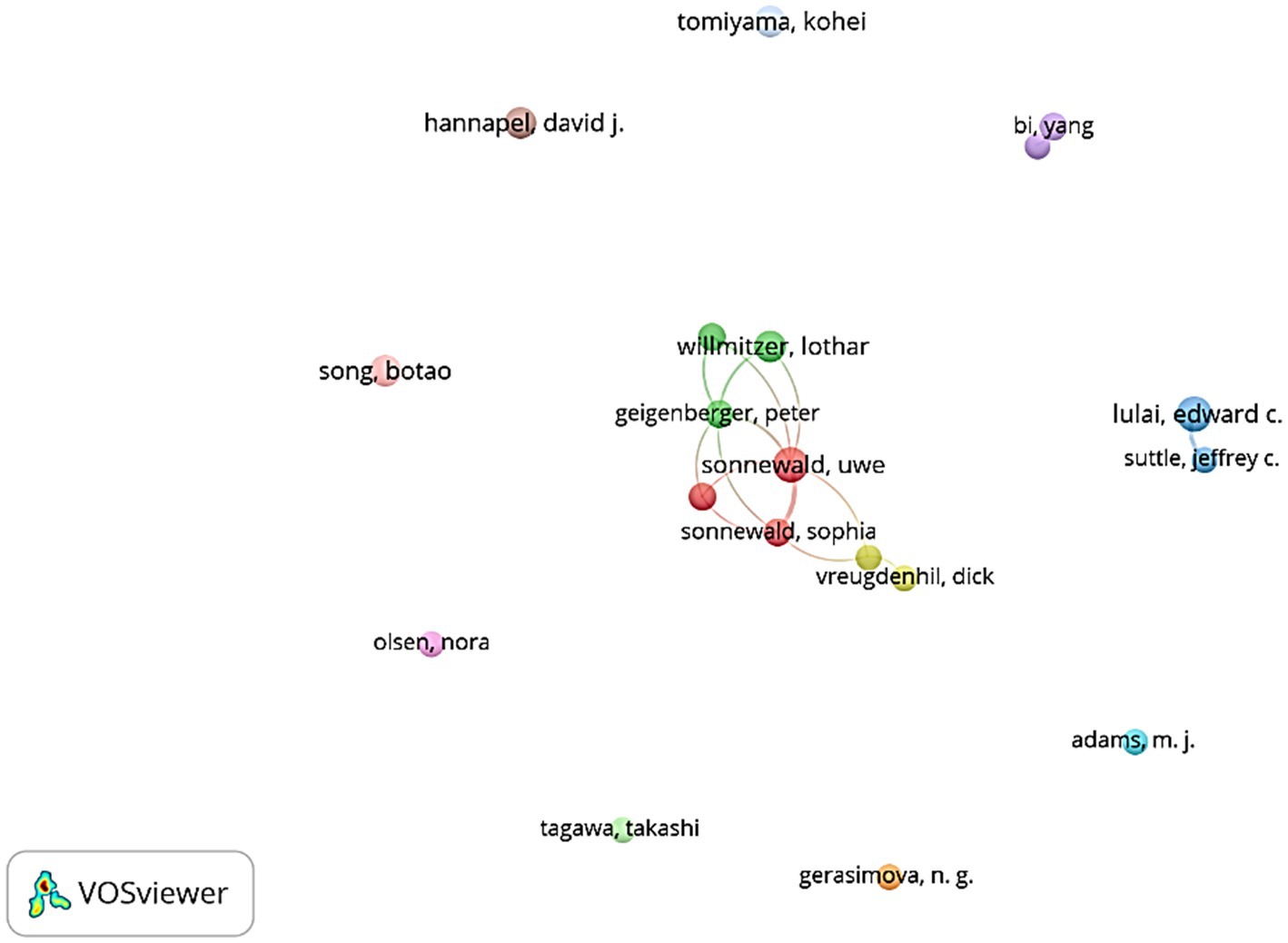
Figure 6. Co-authorship of authors network map who are working in the area of potato seed development.
In our investigation, we analyzed 12 clusters, which were not interconnected since we did not restrict linking them with the author groups in our analysis. However, we observed that the three cluster groups were closely related. Another crucial aspect of co-authorship analysis is the identification and quantification of distinct types of collaborations, including intra-institutional, inter-institutional, international, and interdisciplinary collaborations. This approach can provide valuable insights into the dynamics of research collaborations and the factors that influence cross-disciplinary or cross-institutional collaborations. Additionally, co-authorship analysis can be leveraged to detect emerging research trends and topics of investigation. By analyzing co-authorship networks, researchers can assess the influence of research collaborations on scientific output, citation impact, and scientific recognition. The co-authorship analysis is a useful tool for understanding the complex dynamics of research collaborations and has become an essential component of bibliometric analysis in various fields of study. By applying this method, researchers can gain valuable insights into the structure and organization of the research community, which can inform policies and strategies to foster international scientific collaboration and innovation.
Co-authorship analysis of countries
The analysis of the country’s collaboration network revealed about 101 findings. To ensure robustness and reliability, we focused on 33 nations with at least 5 documents published each (approximately 3% of the total number of publications). This analysis identified six distinct clusters that emerged from the investigation. These clusters are represented by different colors, including yellow, green, red, purple, blue, and sky blue. Each cluster illustrates the scientific relationships between the countries involved in the collaboration. Using network analysis allowed us to better understand the complex dynamics of scientific collaboration between countries. By identifying these clusters, we can better understand the collaboration patterns and the factors that promote or inhibit scientific collaboration between nations. Overall, this type of analysis provides valuable insights into the structure and organization of the global scientific community, which can inform policies and strategies to enhance international scientific collaboration and innovation.
Our analysis revealed that the United States, Germany, the United Kingdom, the Netherlands, Canada, and China had more than 1,000 citations, indicating that these countries had a significant impact in the field. This observation is also reflected in Figure 7, which shows the citation impact of each country. Furthermore, we found that the United States released the highest number of documents (192 publications), followed by the United Kingdom (98 publications) and China (83 publications). These results are also illustrated in Figure 8, which presents the country collaboration map. By examining the country collaboration map, we can better understand the scientific relationships between countries in the field. This type of analysis is essential for identifying potential opportunities for collaboration and innovation and understanding the factors that facilitate or hinder scientific collaboration between countries. Our analysis provides valuable insights into the global landscape of research in the field and can inform policies and strategies to enhance international scientific collaboration and innovation.
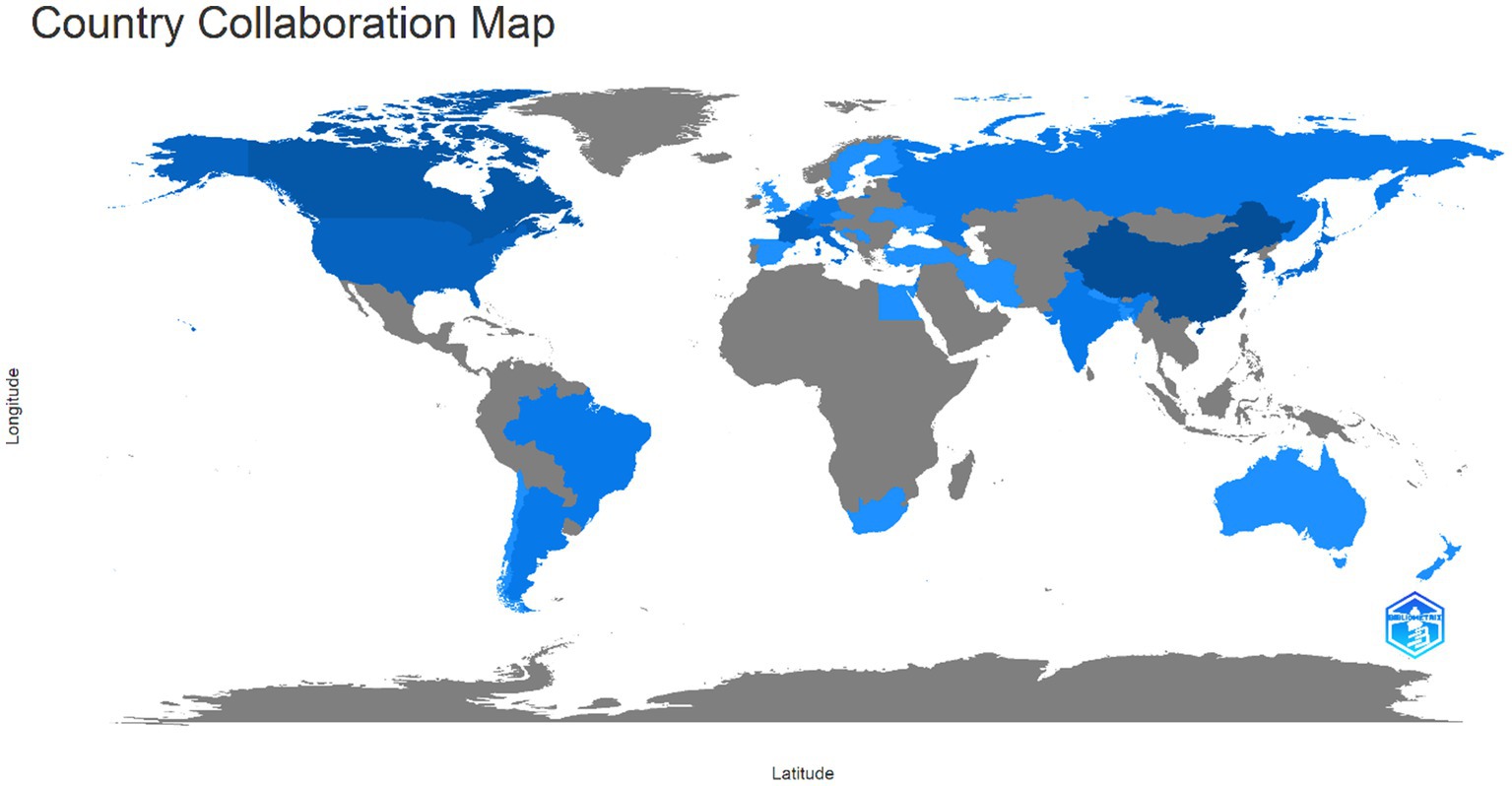
Figure 8. Country collaboration map where the publication and author are working on potato seed development.
On the country collaboration map, the blue color represents international research collaboration, which highlights the countries that have collaborated across national borders to produce research on potato seed development. Additionally, the pink band connecting the states illustrates the level of collaboration among authors within each country. It is fascinating to observe how the countries with the most publications on potato seed development have collaborated with others, despite sometimes being geographically distant. For example, the United States, China, Germany, and the United Kingdom have engaged in significant collaborations with countries from different world regions. While such collaborations may not directly contribute to developing the theme, they can lead to sharing policies and knowledge and foster market collaboration. Therefore, promoting international scientific collaboration to enhance innovation and knowledge transfer is crucial, ultimately driving progress and development in the field.
Most cited sources
Vosviewer was used to analyze the most cited sources, giving us an overview of the impactful journals. Seven clusters formed in the analysis can be linked with the underlying theme on which publications were done. From the analysis, research on potato seed development themes was highly diverse and dispersed among various journals. The most productive journals that emerged from the analysis were Potato Research, American Journal of Potato Research, Plant Physiology, Plant Disease, etc. They were the contact point in each cluster. The journals that emerged in the analysis were exclusively related to Potato, showing that researchers were more interested in publishing in themed journals (Figure 9).
Citation analysis is a valuable approach for evaluating the influence and impact of academic journals. In our study, we conducted a citation analysis and found that certain journals received a higher number of citations in the field of potato seed research. Notably, the most frequently cited journals were Potato Research, Plant Physiology, and the American Journal of Potato Research. This observation suggests that journals publishing a significant number of papers related to potato seed development tend to receive citations from studies in the same research domain.
Conclusion
The paper has presented an overview of research papers using bibliometric analysis of articles published from 1974 to 2023. There was an increasing trend of publications on potato seed research with a peak in the year 2020 while the citations increased at a moderate rate and it continued to increase. Our analysis was based on Dimensions database. In order to mitigate the scarcity of good quality potato seeds, a variety of strategies have been explored. These include the use of tissue culture, aeroponic systems, and apical rooted cuttings, all of which have shown promise in producing high-quality potato seeds. It is important to recognize that these new technologies need to be carefully considered and promoted in developing countries to increase potato productivity. In areas with high disease pressure, the hi-tech seed potato production system has the advantage of maintaining better health status of seed stocks due to the reduced number of field multiplications compared to the conventional (clonal multiplication) system. Moreover, there is a pressing need for greater efficiency and reduced energy inputs in seed potato production. Therefore, research on soil-free techniques will continue to be a focal point in established and developing potato-producing areas in the near and distant future. As engineering technology advances, it will assist in developing more automated and controlled seed propagation systems. Analysis conducted in the study included authorship analysis, Co-authorship analysis among countries, citation analysis of sources, etc. The research on potato seed development indicated a trend toward sustainable development and SDG goal 2. The scope of search results was limited, but it paves the way for future research as more large-scale and impactful studies on potato seed development research are required. Policy-makers and researchers can further develop studies and collaborate with other organizations to help achieve the SDG goal.
Data availability statement
The original contributions presented in the study are included in the article/supplementary material, further inquiries can be directed to the corresponding authors.
Author contributions
PL, ML, RT, and AK: conceptualization and design. MY, BB, ES, and MA: interpretation of data and original draft preparation. PL, RK, and ES: analysis and interpretation of data and writing. MY, MA, RJ, AA and AD: performed analysis, interpretation of data and resources. RK, AA, BS, and AK: revised draft manuscript and supervision. All authors read and approved the final manuscript.
Acknowledgments
The authors would like to acknowledge the Director of ICAR Central Potato Research Institute, Shimla for constant support and guidance. The authors would like to extend their sincere appreciation to the Researchers Supporting Project Number (RSP2023R350), King Saud University, Riyadh, Saudi Arabia.
Conflict of interest
The remaining authors declare that the research was conducted in the absence of any commercial or financial relationships that could be construed as a potential conflict of interest.
Publisher’s note
All claims expressed in this article are solely those of the authors and do not necessarily represent those of their affiliated organizations, or those of the publisher, the editors and the reviewers. Any product that may be evaluated in this article, or claim that may be made by its manufacturer, is not guaranteed or endorsed by the publisher.
References
Afrifa, S., Zhang, T., Appiahene, P., and Varadarajan, V. (2022). Mathematical and machine learning models for groundwater level changes: a systematic review and bibliographic analysis. Future Internet 14:259. doi: 10.3390/FI14090259
Aliche, E. B., Theeuwen, T. P. J. M., Oortwijn, M., Visser, R. G. F., and van der Linden, C. G. (2020). Carbon partitioning mechanisms in POTATO under drought stress. Plant Physiol. Biochem. 146, 211–219. doi: 10.1016/j.plaphy.2019.11.019
Almekinders, C. J. M., Chujoy, E., and Thiele, G. (2009). The use of true potato seed as pro-poor technology: the efforts of an international agricultural research institute to innovating potato production. Potato Res. 52, 275–293. doi: 10.1007/S11540-009-9142-5/TABLES/3
Buckseth, T., Tiwari, J. K., Singh, R. K., Kumar, V., Sharma, A. K., Dalamu, D., et al. (2022). Advances in innovative seed potato production systems in India. Front. Agron. 4:81. doi: 10.3389/FAGRO.2022.956667/BIBTEX
de Sousa, F. D. B. (2021). Management of plastic waste: a bibliometric mapping and analysis. Waste Manag. Res. 39, 664–678. doi: 10.1177/0734242X21992422
Devaux, A., Goffart, J. P., Kromann, P., Andrade-Piedra, J., Polar, V., and Hareau, G. (2021). The potato of the future: opportunities and challenges in sustainable agri-food systems. Potato Res. 64, 681–720. doi: 10.1007/s11540-021-09501-4
Devaux, A., Goffart, J. P., Petsakos, A., Kromann, P., Gatto, M., Okello, J., et al. (2019). “Global food security, contributions from sustainable potato agri-food systems” in The potato crop: its agricultural, nutritional and social contribution to humankind. eds. H. Campos and O. Ortiz (Cham: Springer), 3–35.
do Prado, J. W., de Castro Alcântara, V., de Melo Carvalho, F., Vieira, K. C., Machado, L. K. C., and Tonelli, D. F. (2016). Multivariate analysis of credit risk and bankruptcy research data: a bibliometric study involving different knowledge fields (1968–2014). Scientometrics 106, 1007–1029. doi: 10.1007/S11192-015-1829-6/FIGURES/9
Ezekiel, R., and Singh, B. (2007a). Changes in contents of sugars, free amino acids and phenols in four varieties of potato tubers stored at five temperatures for 180 days. J. Food Sci. Technol. 44, 471–477.
Ezekiel, R., and Singh, B. (2007b). Effect of cooking and processing on CIPC residue concentrations in potatoes and processed potato products. Potato Res. 50, 175–184. doi: 10.1007/s11540-008-9043-z
FAOSTAT. (2019). FAO statistics database on the world wide web. Available at: http://www.fao.org/faostat/en/#data/QC/visualize
Frost, K. E., Groves, R. L., and Charkowski, A. O. (2013). Integrated control of potato pathogens through seed potato certification and provision of clean seed potatoes. Plant Dis 97, 1268–1280. doi: 10.1094/PDIS-05-13-0477-FE
Goffart, J. P., Haverkort, A., Storey, M., Haase, N., Martin, M., Lebrun, P., et al. (2022). Potato production in northwestern Europe (Germany, France, the Netherlands, United Kingdom, Belgium): characteristics, issues, challenges and opportunities. Potato Res. 65, 503–547. doi: 10.1007/S11540-021-09535-8/TABLES/14
Groos, O. V., and Pritchard, A. (1969). Documentation notes. J. Doc. 25, 344–349. doi: 10.1108/EB026482/FULL/XML
Janssens, S. R. M., Wiersema, S. G., Goos, H. J. T., and Wiersma, W. (2013). The value chain for seed and ware potatoes in Kenya: opportunities for development. LEI-Wageningen UR, Den Haag.
Jefferies, R. A. (1996). Evaluation of seedling selection for salinity tolerance in potato (Solanum tuberosum L.). Euphytica 88, 207–213. doi: 10.1007/BF00023892
Kumar, R., Lal, M.K., Tiwari, R. K., Chourasia, K. N., Kumari, A., Kumar, R., et al. (2023). Investigating the Interplay between Tomato Leaf Curl New Delhi Virus Infection, Starch Metabolism and Antioxidant Defence System in Potato. (Solanum tuberosum L.). Antioxidants, 12:1447.
Kumar, R., Kaundal, P., Tiwari, R. K., Siddappa, S., Kumari, H., Chandra Naga, K., et al. (2021). Rapid and sensitive detection of potato virus X by one-step reverse transcription-recombinase polymerase amplification method in potato leaves and dormant tubers. Mol. Cell. Probes 58:101743. doi: 10.1016/J.MCP.2021.101743
Kumar, R., Kaundal, P., Tiwari, R. K., Siddappa, S., Kumari, H., Lal, M. K., et al. (2022). Establishment of a one-step reverse transcription recombinase polymerase amplification assay for the detection of potato virus S. J. Virol. Methods 307:114568. doi: 10.1016/J.JVIROMET.2022.114568
Lal, P., Behera, B., Yadav, M. R., Sharma, E., Altaf, M. A., Dey, A., et al. (2023). A bibliometric analysis of groundwater access and its management: making the invisible visible. Water 15:806. doi: 10.3390/W15040806
Martín-Martín, A., Orduna-Malea, E., and Delgado López-Cózar, E. (2018). Coverage of highly-cited documents in Google scholar, web of science, and Scopus: a multidisciplinary comparison. Scientometrics 116, 2175–2188. doi: 10.1007/S11192-018-2820-9/FIGURES/1
Martín-Martín, A., Thelwall, M., Orduna-Malea, E., and Delgado López-Cózar, E. (2021). Google scholar, Microsoft academic, Scopus, dimensions, web of science, and open Citations' COCI: a multidisciplinary comparison of coverage via citations. Scientometrics 126, 871–906. doi: 10.1007/S11192-020-03690-4/FIGURES/10
Nagaich, B. B., Pushkarnath Bharadwaj, V. P., Giri, B. K., Anand, S. R., and Upreti, G. C. (1969). Production of disease-free seed potatoes in the indo-Gangetic plains. Indian J. Agric. Sci. 39, 238–243.
Pandey, S. K., Marwaha, R. S., Dinesh, K., and Singh, S. V. (2009). Indian potato processing story: industrial limitations, challenges ahead and vision for the future. Potato J. 36, 1–13.
Patel, S. K., Sharma, A., and Singh, G. S. (2020). Traditional agricultural practices in India: an approach for environmental sustainability and food security. Energy Ecol. Environ. 5, 253–271. doi: 10.1007/S40974-020-00158-2/METRICS
Paul, V., Buckseth, T., Singh, R. K., Ravichandran, G., Lal, M. K., Singh, B., et al. (2022). Alternative methods of seed potato (Solanum tuberosum) production: Indian perspective—a review. Curr. Hortic. 10, 3–11. doi: 10.5958/2455-7560.2022.00019.X
Paul, V., Ezekiel, R., and Pandey, R. (2016). Cold storage in India: present scenario and future directions. Process. Food Industry 19, 25–28.
Pizzi, S., Caputo, A., Corvino, A., and Venturelli, A. (2020). Management research and the UN sustainable development goals (SDGs): a bibliometric investigation and systematic review. J. Clean. Prod. 276:124033. doi: 10.1016/J.JCLEPRO.2020.124033
Pretty, J. N., Morison, J. I. L., and Hine, R. E. (2003). Reducing food poverty by increasing agricultural sustainability in developing countries. Agric. Ecosyst. Environ. 95, 217–234. doi: 10.1016/S0167-8809(02)00087-7
Rahman, M., and Akanda, A. (1970). Effect of PLRV infected seed tuber on disease incidence, plant grow As the foundation th and yield parameters of potato. Bangladesh J. Agric. Res. 35, 359–366. doi: 10.3329/bjar.v35i3.6441
Roemer, R. C., and Borchardt, R. (2015). Meaningful metrics: a 21st century Librarian's guide to bibliometrics, altmetrics, and research impact. Available at: http://localhost:8080/xmlui/handle/123456789/6663
Sattar, F. A., Hamooh, B. T., Wellman, G., Ali, M. A., Shah, S. H., Anwar, Y., et al. (2021). Growth and biochemical responses of potato cultivars under in vitro Lithium chloride and mannitol simulated salinity and drought stress. Plan. Theory 10:924. doi: 10.3390/PLANTS10050924
Shaheb, M. R. S., Begum, M. M., Ahmed, K. U., Nazrul, M. I., and Wiersema, S. G. (2015). Challenges of seed potato (Solanum tuberosum L.) production and supply system in Bangladesh - a review. Agriculturists 13, 173–188. doi: 10.3329/AGRIC.V13I1.26560
Singh, H. P., Singh, B., and Kumar, R. (2023). Approaches to sustaining potato production in India, technical bulletin 2023, Confederation of Horticulture Associations of India, New Delhi.
Sweileh, W. M. (2020). Bibliometric analysis of scientific publications on “sustainable development goals” with emphasis on “good health and wellbeing” goal (2015-2019). Glob. Health 16, 1–13. doi: 10.1186/S12992-020-00602-2/FIGURES/5
van Eck, N. J., and Waltman, L. (2011). Text mining and visualization using VOSviewer. ISSI Newslett 7, 50–54. doi: 10.48550/arXiv.1109.2058
van Eck, N. J., and Waltman, L. (2017). Citation-based clustering of publications using CitNetExplorer and VOSviewer. Scientometrics 111, 1053–1070. doi: 10.1007/S11192-017-2300-7/TABLES/4
van Eck, N. J., Waltman, L., Dekker, R., and van den Berg, J. (2010). A comparison of two techniques for bibliometric mapping: multidimensional scaling and VOS. J. Am. Soc. Inf. Sci. Technol. 61, 2405–2416. doi: 10.1002/ASI.21421
Walker, T. S., Schmiediche, P. E., and Hijmans, R. J. (1999). World trends and patterns in the potato crop: an economic and geographic survey. Potato Res. 42, 241–264. doi: 10.1007/BF02357856/METRICS
Keywords: potato seed, bibliometric analysis, SDG 2, zero hunger, food security
Citation: Lal P, Tiwari RK, Behera B, Yadav MR, Sharma E, Altaf MA, Jena R, Ahmad A, Dey A, Kumar A, Singh S, Lal MK and Kumar R (2023) Exploring potato seed research: a bibliometric approach towards sustainable food security. Front. Sustain. Food Syst. 7:1229272. doi: 10.3389/fsufs.2023.1229272
Edited by:
Xiukang Wang, Yan'an University, ChinaReviewed by:
Vinit Kumar, Babasaheb Bhimrao Ambedkar University, IndiaJustice Gameli Djokoto, Central University, Ghana
Copyright © 2023 Lal, Tiwari, Behera, Yadav, Sharma, Altaf, Jena, Ahmad, Dey, Kumar, Singh, Lal and Kumar. This is an open-access article distributed under the terms of the Creative Commons Attribution License (CC BY). The use, distribution or reproduction in other forums is permitted, provided the original author(s) and the copyright owner(s) are credited and that the original publication in this journal is cited, in accordance with accepted academic practice. No use, distribution or reproduction is permitted which does not comply with these terms.
*Correspondence: Rahul Kumar Tiwari, rahultiwari226@gmail.com; Milan Kumar Lal, milan.lal@icar.gov.in; Ravinder Kumar, chauhanravinder97@gmail.com
 Priyanka Lal
Priyanka Lal Rahul Kumar Tiwari
Rahul Kumar Tiwari Biswaranjan Behera3
Biswaranjan Behera3  Eshita Sharma
Eshita Sharma Muhammad Ahsan Altaf
Muhammad Ahsan Altaf Rupak Jena
Rupak Jena Ajaz Ahmad
Ajaz Ahmad Awadhesh Kumar
Awadhesh Kumar Milan Kumar Lal
Milan Kumar Lal Ravinder Kumar
Ravinder Kumar